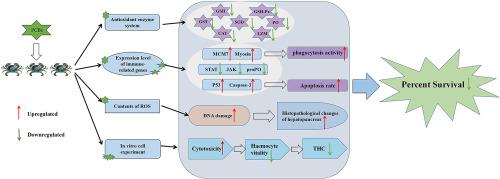Environmental Pollution ( IF 8.9 ) Pub Date : 2021-09-25 , DOI: 10.1016/j.envpol.2021.118229 Chongyang Xiao 1 , Yunfei Zhang 1 , Fei Zhu 1

|
Polychlorinated biphenyls (PCBs) are persistent organic pollutants in environments, and they can negatively affect aquatic animal health. After 7 days of PCBs exposure, the activities of catalase, phenoloxidase, and superoxide dismutase and the total hemocyte count in the haemolymph were significantly decreased and the reactive oxygen species (ROS) content and phagocytic rate of hemocytes were significantly increased in mud crab Scylla paramamosain. Additionally, serum lysozyme, glutathione, glutathione-S-transferase, and glutathione peroxidase activities were significantly down-regulated in mud crab after PCBs exposure. The survival rate of crab hemocytes significantly declined as the PCBs concentration increased, indicating that PCBs had a cytotoxic effect on hemocytes. Exposure to increasing concentrations of PCBs also increased the degree of DNA damage in crab hemocytes. After PCBs exposure, the expression levels of P53 and caspase-3 in hemocytes were significantly up-regulated, which suggests that apoptosis was occurring. The apoptosis rate of hemocytes was up-regulated as the PCBs concentration increased, indicating that apoptosis was induced by the PCBs-activated caspase-3 pathway. These data suggest that exposure to PCBs hampered the immune response of mud crabs, most likely by (1) inducing ROS, causing DNA damage, and reducing the viability of hemocytes, (2) reducing the activities of antioxidant enzymes, and (3) inducing phagocytosis and apoptosis of hemocytes. And the final result of PCBs-induced immunotoxicity to mud crabs is the reduced bacterial disease resistance and survival rate of crabs under Vibrio alginolyticus challenge.
中文翻译:

多氯联苯 (PCB) 对海洋甲壳类动物 Scylla paramamosain 的免疫毒性
多氯联苯 (PCB) 是环境中的持久性有机污染物,会对水生动物的健康产生负面影响。PCBs暴露7 d后,泥蟹Scylla paramamosain血淋巴中过氧化氢酶、酚氧化酶和超氧化物歧化酶活性和血细胞总数显着降低,血细胞活性氧(ROS)含量和吞噬率显着升高。. 此外,多氯联苯暴露后泥蟹的血清溶菌酶、谷胱甘肽、谷胱甘肽-S-转移酶和谷胱甘肽过氧化物酶活性显着下调。随着PCBs浓度的增加,蟹血细胞的存活率显着下降,表明PCBs对血细胞具有细胞毒作用。暴露于浓度增加的多氯联苯也会增加蟹血细胞中 DNA 的损伤程度。PCBs暴露后,血细胞中P53和caspase-3的表达水平显着上调,表明细胞凋亡正在发生。随着PCBs浓度的增加,血细胞的凋亡率上调,表明细胞凋亡是由PCBs激活的caspase-3途径诱导的。这些数据表明,接触多氯联苯会阻碍泥蟹的免疫反应,最有可能的原因是(1)诱导 ROS,引起 DNA 损伤,降低血细胞的活力,(2)降低抗氧化酶的活性,以及(3)诱导血细胞的吞噬和凋亡。而多氯联苯对泥蟹的免疫毒性最终导致泥蟹的细菌抗病能力和成活率降低。溶藻弧菌挑战。


























 京公网安备 11010802027423号
京公网安备 11010802027423号